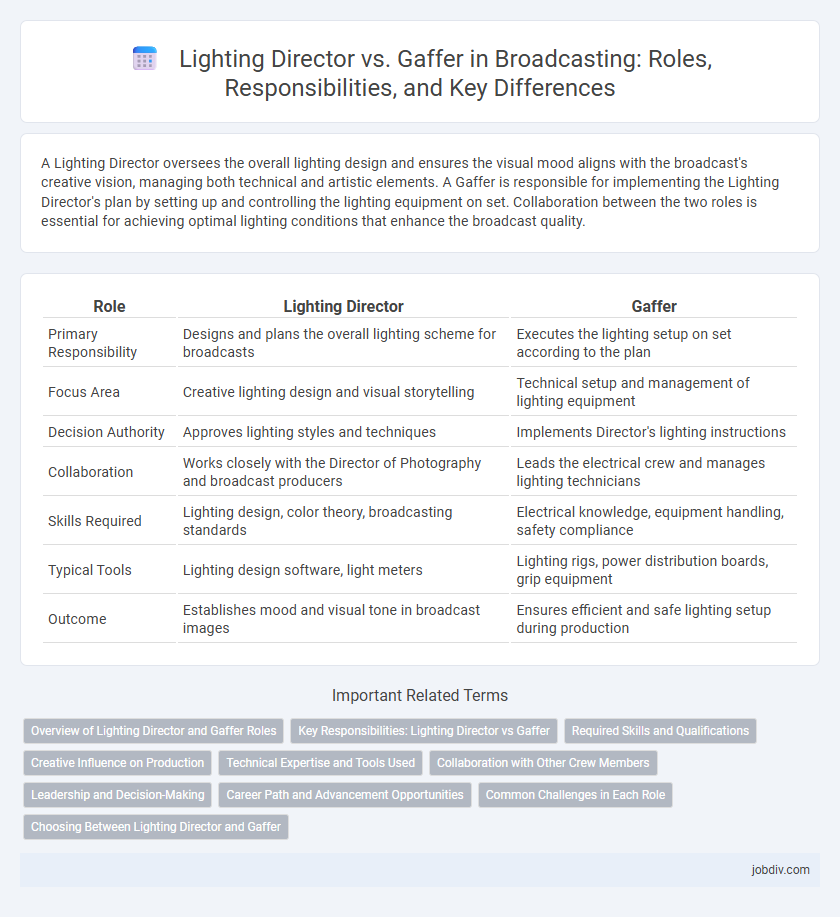A Lighting Director oversees the overall lighting design and ensures the visual mood aligns with the broadcast's creative vision, managing both technical and artistic elements. A Gaffer is responsible for implementing the Lighting Director's plan by setting up and controlling the lighting equipment on set. Collaboration between the two roles is essential for achieving optimal lighting conditions that enhance the broadcast quality.
Table of Comparison
| Role | Lighting Director | Gaffer |
|---|---|---|
| Primary Responsibility | Designs and plans the overall lighting scheme for broadcasts | Executes the lighting setup on set according to the plan |
| Focus Area | Creative lighting design and visual storytelling | Technical setup and management of lighting equipment |
| Decision Authority | Approves lighting styles and techniques | Implements Director's lighting instructions |
| Collaboration | Works closely with the Director of Photography and broadcast producers | Leads the electrical crew and manages lighting technicians |
| Skills Required | Lighting design, color theory, broadcasting standards | Electrical knowledge, equipment handling, safety compliance |
| Typical Tools | Lighting design software, light meters | Lighting rigs, power distribution boards, grip equipment |
| Outcome | Establishes mood and visual tone in broadcast images | Ensures efficient and safe lighting setup during production |
Overview of Lighting Director and Gaffer Roles
Lighting Directors oversee the overall lighting design and execution for broadcasting productions, ensuring optimal visual aesthetics and mood aligned with the director's vision. Gaffers manage the technical aspects of lighting setup, including rigging, positioning, and operating lighting equipment on set or location. Both roles collaborate closely to achieve precise lighting effects crucial for high-quality broadcast visuals.
Key Responsibilities: Lighting Director vs Gaffer
The Lighting Director oversees the overall lighting design and creative vision for a production, ensuring that lighting enhances the mood, tone, and visual storytelling. The Gaffer implements the Lighting Director's plan by managing the electrical crew, setting up lighting instruments, and controlling the technical aspects of light on set. Both roles collaborate closely to balance artistic intent with practical execution to achieve optimal lighting effects.
Required Skills and Qualifications
A Lighting Director must possess strong leadership skills, deep technical knowledge of lighting design, and proficiency in advanced lighting control systems to create mood and atmosphere for broadcast productions. A Gaffer requires hands-on expertise in setting up, maintaining, and troubleshooting lighting equipment, along with excellent teamwork abilities and a detailed understanding of electrical safety standards. Both roles demand experience in color temperature management, familiarity with lighting software, and the ability to adapt to fast-paced production environments.
Creative Influence on Production
The Lighting Director shapes the overall visual mood and atmosphere by designing light schemes that align with the director's vision, influencing how the story emotionally resonates on screen. The Gaffer executes these designs, managing the technical setup and adjustments on set to ensure lighting consistency and quality throughout production. Both roles collaborate closely, but the Lighting Director holds primary creative influence on the aesthetic impact of lighting in broadcasting productions.
Technical Expertise and Tools Used
Lighting Directors oversee the creative and technical aspects of lighting design in broadcasting, utilizing advanced lighting consoles and software to control intensity, color, and effects with precision. Gaffers specialize in executing the Lighting Director's vision by managing physical lighting equipment such as HMI lights, LED panels, and grip gear to ensure proper illumination and mood on set. Both roles require deep technical expertise, but the Lighting Director emphasizes design and programming, while the Gaffer focuses on equipment setup and real-time adjustments.
Collaboration with Other Crew Members
The Lighting Director coordinates closely with the Gaffer to design and implement the lighting plan that achieves the director's visual vision while meeting technical requirements. The Gaffer supervises the lighting crew, ensuring the setup aligns with the Lighting Director's specifications and cinematographer's needs on set. Effective collaboration between these roles ensures seamless integration of artistic intent and practical execution in broadcasting productions.
Leadership and Decision-Making
A Lighting Director oversees the entire lighting design and execution for a broadcast production, making strategic decisions to align lighting with the director's vision and production requirements. The Gaffer leads the electrical crew, executing the Lighting Director's plan by managing the technical setup, troubleshooting, and maintaining on-set lighting equipment. Leadership from the Lighting Director involves creative decision-making and coordination across departments, while the Gaffer's leadership centers on practical team management and precise implementation under time constraints.
Career Path and Advancement Opportunities
Lighting Directors typically pursue careers by gaining experience in broadcast production and developing leadership skills to manage lighting design teams, often advancing into senior creative or technical roles within television studios or live event productions. Gaffers usually start as electricians or lighting technicians, mastering on-set lighting setups before progressing to supervisory roles or transitioning into Lighting Director positions in larger-scale broadcasting projects. Career advancement for Lighting Directors focuses on creative direction and management, while Gaffers advance through technical expertise and hands-on experience with complex lighting rigs.
Common Challenges in Each Role
Lighting Directors often face the challenge of balancing creative vision with technical constraints, ensuring lighting complements the narrative while operating within budget and time limits. Gaffers frequently manage the complexities of executing the Lighting Director's plans on set, troubleshooting electrical issues, and maintaining safety protocols amid fast-paced shooting schedules. Both roles must adapt to dynamically changing set conditions, collaborate closely with the cinematography team, and optimize lighting setups for varying camera angles and scenes.
Choosing Between Lighting Director and Gaffer
Choosing between a Lighting Director and a Gaffer depends on the scale and complexity of the broadcast production. A Lighting Director oversees the overall lighting design and creative decisions to enhance the visual storytelling, while a Gaffer executes the technical setup and manages lighting equipment on set. For large-scale broadcasts with complex lighting needs, the Lighting Director's strategic vision is crucial, whereas smaller productions often rely primarily on the Gaffer's technical expertise.
Lighting Director vs Gaffer Infographic

 jobdiv.com
jobdiv.com